Our mission is to promote education and fellowship through the sharing of information and the promotion of the world's greatest hobby. - Model Railroading.

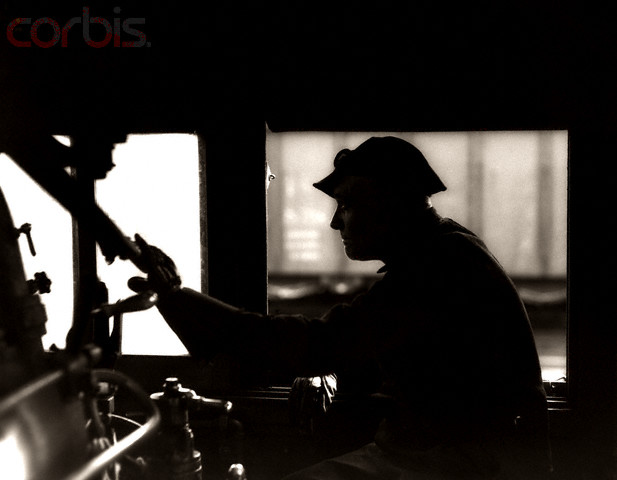 Recently the Superintendent of Division Eight here in the NCR posted a column to his division newsletter regarding the different ways we process information and how it relates to model railroading. It got me thinking about some things I'd like to share with you. Basically, we associate the right side of our brains with creative, artistic, and "abstract" thinking. The left lobe is where we deal with facts, information, and "technical" thinking. I've heard this truth summarized as "right brain savvy, left brain smarts". Model railroading places significant demand on both sides and I've been thinking about how important this balancing act is. I tend to "lean left" by doing lots of research, relying on detailed plans, and measuring things precisely. Right now I have a number of projects under way that lack a lot of information. However, I do have many photos at my disposable. This is where I've got to shift to my right brain and "channel my inner artist". Think about that. Do you see model railroading as an art form? Consider a painter gazing out over his easel at a beautiful scene. Does he have blueprints, specifications, and data? No, he replicates on canvas what his eye sees, and we've all marvelled at how realistically some can do that. We do the same thing when we construct scenery because that task just draws from our right brain naturally. But what about a locomotive, or structure, or freight car? I'm slowly realizing that sometimes I need to take the technical info I have available and simply "do the art": visually copy the real subject as well as I can by eye. After all, isn't that the way it will be perceived and processed by other folks' brains? In the end, no one views a model railroad with a ruler, micrometer, or calliper. The objective is to look like the real thing. If you are wired like I am, we need to avoid getting bogged down in too much research to the point that the project never gets done. I've been fighting my natural tendencies for a long time, but I'm getting there. The process is liberating, and I find that I really can copy things pretty well if I apply my (right) mind to it. I think this progress makes me a better modeler, stimulates creativity, adds productivity, and kick-starts me to build some things I would not have if my techie left brain called all the shots!
Recently the Superintendent of Division Eight here in the NCR posted a column to his division newsletter regarding the different ways we process information and how it relates to model railroading. It got me thinking about some things I'd like to share with you. Basically, we associate the right side of our brains with creative, artistic, and "abstract" thinking. The left lobe is where we deal with facts, information, and "technical" thinking. I've heard this truth summarized as "right brain savvy, left brain smarts". Model railroading places significant demand on both sides and I've been thinking about how important this balancing act is. I tend to "lean left" by doing lots of research, relying on detailed plans, and measuring things precisely. Right now I have a number of projects under way that lack a lot of information. However, I do have many photos at my disposable. This is where I've got to shift to my right brain and "channel my inner artist". Think about that. Do you see model railroading as an art form? Consider a painter gazing out over his easel at a beautiful scene. Does he have blueprints, specifications, and data? No, he replicates on canvas what his eye sees, and we've all marvelled at how realistically some can do that. We do the same thing when we construct scenery because that task just draws from our right brain naturally. But what about a locomotive, or structure, or freight car? I'm slowly realizing that sometimes I need to take the technical info I have available and simply "do the art": visually copy the real subject as well as I can by eye. After all, isn't that the way it will be perceived and processed by other folks' brains? In the end, no one views a model railroad with a ruler, micrometer, or calliper. The objective is to look like the real thing. If you are wired like I am, we need to avoid getting bogged down in too much research to the point that the project never gets done. I've been fighting my natural tendencies for a long time, but I'm getting there. The process is liberating, and I find that I really can copy things pretty well if I apply my (right) mind to it. I think this progress makes me a better modeler, stimulates creativity, adds productivity, and kick-starts me to build some things I would not have if my techie left brain called all the shots!
See ya on down the line,
Dave McMullian,
Superintendent
 Did we not just have a meeting???????? Was it not only 2 weeks ago when I was putting together the January Train Order, time surely does fly when you are having fun. Note: Great minds think a like - Norm.
Did we not just have a meeting???????? Was it not only 2 weeks ago when I was putting together the January Train Order, time surely does fly when you are having fun. Note: Great minds think a like - Norm.
Just before Christmas I was going to visit with Dave McMullian, and as I was driving along rt163, towards Stony Ridge, just after rt420, I got stopped by this dirty big blue machine, with a yellow front, and the letters CSX on the side. A rare beast for me as I am so used to seeing Norfolk Southern motive power I guess I paid more attention than normal of what was passing in front of me. The train consisted of car carriers, lots and lots of them. What really got my attention was how many different railroad names went past. Once the train had passed, I had seen cars from 3 different countries, and I saw a few railroads I had not heard of, including a railroad called Providence and Worcester Railroad, at least 3 of their cars where part of the train. I guess this means I am now on the lookout for cars from Mexico/Canada/France/Germany to make sure my railroad is realistic!!!
The main reason for going to see Dave was because his railroad is controlled by NCE, like mine (in theory), and he mentioned a couple of words during his DCC talk at the November meeting that made me want to follow up with him. We talked for a good couple of hours, and we covered a lot of thought provoking topics. I went home and got onto amazon web site and ordered parts (nothing to do with what we talked about) in preparation for rewiring my whole layout, sigh. I should have just let the right side control, and not let the left side want to know details. All joking aside, thank you Dave for spending that one on one time with me, it helped clear up a lot of stuff I was over thinking, and pointed me in the right direction.
But, now you realize I am blaming Dave for not volunteering my layout for an open house because I have to rewire. One of these days I will actually get a loco to go all the way around.
Paul Marsden,
Editor
Another Black Swamp Division meeting already! Time flies when you are having fun. We had a great turnout for the last show and tell so lets keep it up. Remember anything about railroads you would like to share qualifies. I even heard a rumor that someone is bringing an actual layout for show and tell!
Here is an update on the monthly layout tours we discussed last meeting. We were going to start them on February 23rd but I'm calling an audible (yes, I miss college football). The long range forecast for the last weekend in February is snow, snow, and more snow. Now I know the forecast is 50/50 but why take the chance. Jerry's outstanding Great Northern layout will be open in March instead, which also gives us the chance to push the other 2 layout owners who volunteered back a month when the weather should be better for the outdoor layouts they have, so I think it is a win-win. We will have all the details about Jerry's layout open house in the March Train Order.
We will have part two of "How to create an Op session" at our February meeting and actually show you how to of create your first op session. We will use an example of a medium size layout with a 75 foot mainline, a couple of towns, and the only yard will be a fiddle staging yard. All we need is the track plan, a list of towns, and the industries on the layout. Hopefully most or all of you did your homework! (remember, create a list of the towns and their industries on your layout of the layout you are planning).
Hope to see you on the 22nd.
Norm Cattell,
Assistant Superintendent

 The corridor between Toledo and Detroit contains several rail lines. The area was a who's who of Northeastern railroad giants. Within the corridor existed the small but highly efficient short line, the Detroit & Toledo Shore Line (reporting mark DTS). The line lasted until 1981 when it was absorbed into one those giants. During its existence the 47-mile double track line was continuously busy and profitable, paying dividends to its owners on a regular basis.
The corridor between Toledo and Detroit contains several rail lines. The area was a who's who of Northeastern railroad giants. Within the corridor existed the small but highly efficient short line, the Detroit & Toledo Shore Line (reporting mark DTS). The line lasted until 1981 when it was absorbed into one those giants. During its existence the 47-mile double track line was continuously busy and profitable, paying dividends to its owners on a regular basis.
The DTS was formed from a failed interurban line in 1899. In 1902 the Grand Trunk Western (GTW) and the Clover Leaf (Toledo, St. Louis and Western Railroad) purchased the line. The GTW wanted direct access to the East-West interchanges in Toledo while the Clover Leaf (later Nickle Plate) wanted access to the growing industrial complexes of Detroit. Once acquired, the line was quickly upgraded to GTW standards.
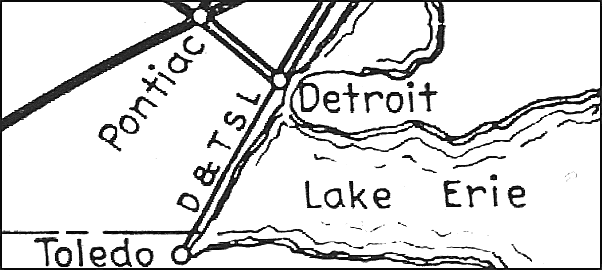
From an early GTW map
As a bridge route with a lot of traffic from the parent roads, the DTS grew and was very profitable even in times when other roads had trouble. During the height of the steam era the line relied on a small fleet of Mikados and Consolidations for most of its main line work. When the line moved to diesels it purchased all EMD units. The DTS purchased its first diesel in 1950 (SW7) and its last in 1953 (GP7). In the end, the entire diesel fleet was 16 units consisting of SW7, SW9 and GP7 units. This fleet would serve the line until 1981 without change.
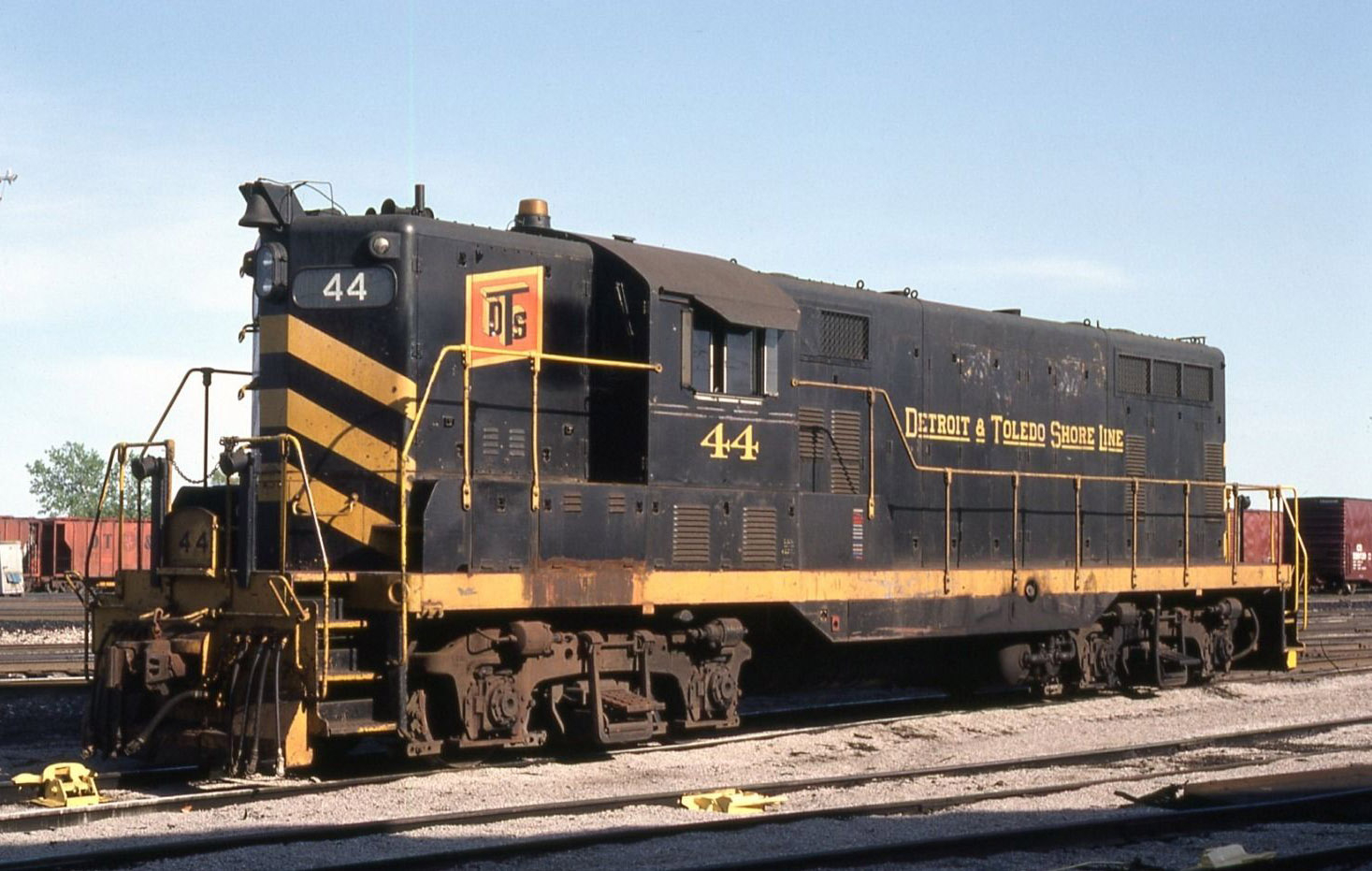
Typical DTS GP7
DTS trains were not limited to DTS trackage. Through trains ran at various points on the GTW with some going all the way to Flint and Port Huron. The GTW also ran through trains over the DTS through to Toledo. In 1981 GTW purchased the 50% from Norfolk Southern and the line became part of GTW as the Shore Line Subdivision.
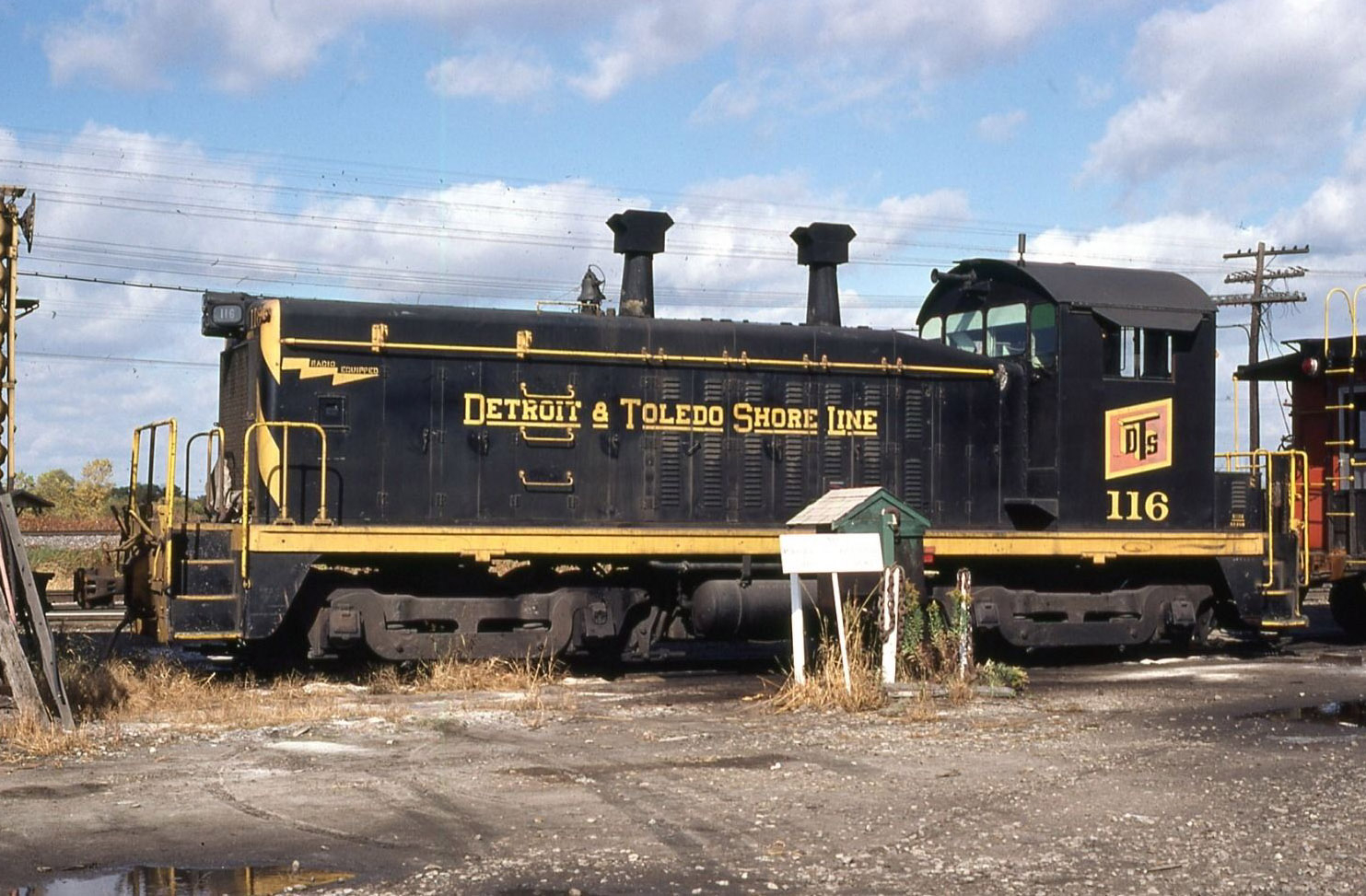
DTS SW7
The DTS handled a large amount of traffic reporting 243 million net ton-miles of revenue freight in 1960. The DTS never handled a single passenger and was a freight only line for its entire existence. Although the line was double tracked, the line did suffer from traffic issues due to its crossing other roads in the congested corridor, especially in West Detroit at Ecorse Jct., NS Bridge, CSX Delray, and the Dix Ave. interlockings.
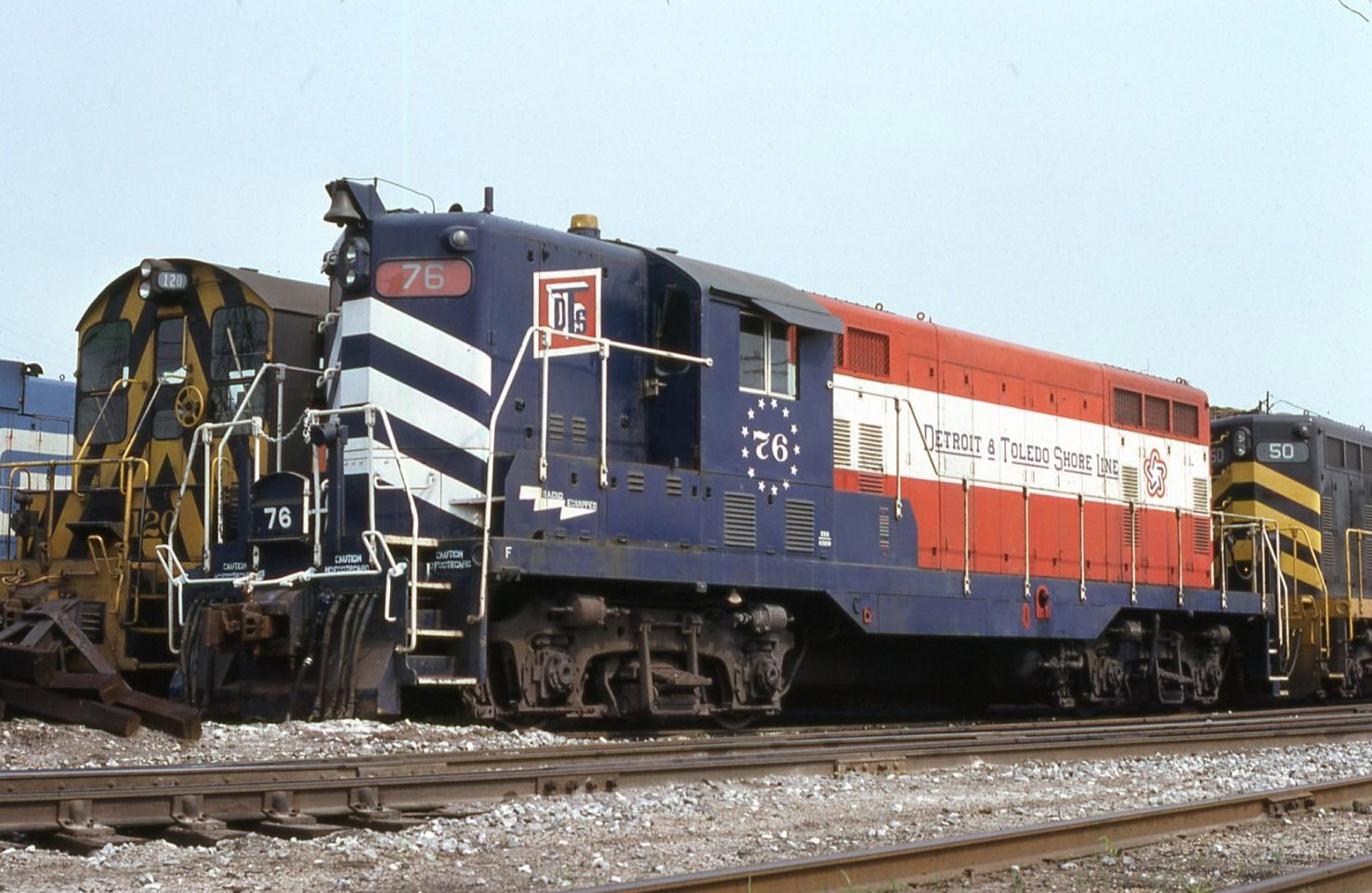
Models of the DTS GP7 and some freight cars are available in N and HO. O scale has a few freight cars. Modelling the DTS could be done on a small or large scale. The DTS served several industries at various points on the line plus had its through freights for operational interest. Occasional flashes of GTW GP38 and GP40 could be introduced to break up the scenes and provide visual interest.
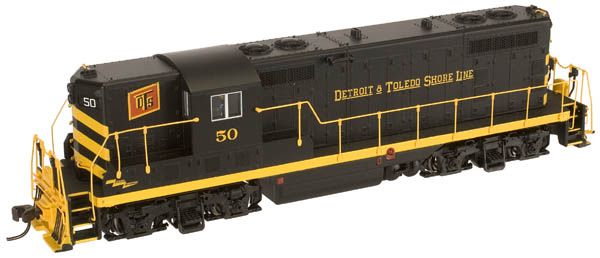
Atlas HO GP7 with DTS paint scheme
Additional information and photographs are available on-line from a variety of sources. Some I found very enjoyable include: Detroit & Toledo Shore Line Diesel Roster - https://www.thedieselshop.us/DTSL.HTML Detroit & Toledo Shore Line Photographic Roster - http://www.rrpicturearchives.net/locolist.aspx?id=DTS
Marshall StullFor other cool articles/stuff written by Marshall, check out his web site - www.smallmr.com
Saw these great images this morning and thought it would be great for the newsletter. These are then and now shots of about the same angle of Deshler OH where the two former B&O lines crossed. Not sure of the year but appears to be early 20th century (1910-1925). Today there is a rail park there at the diamond.
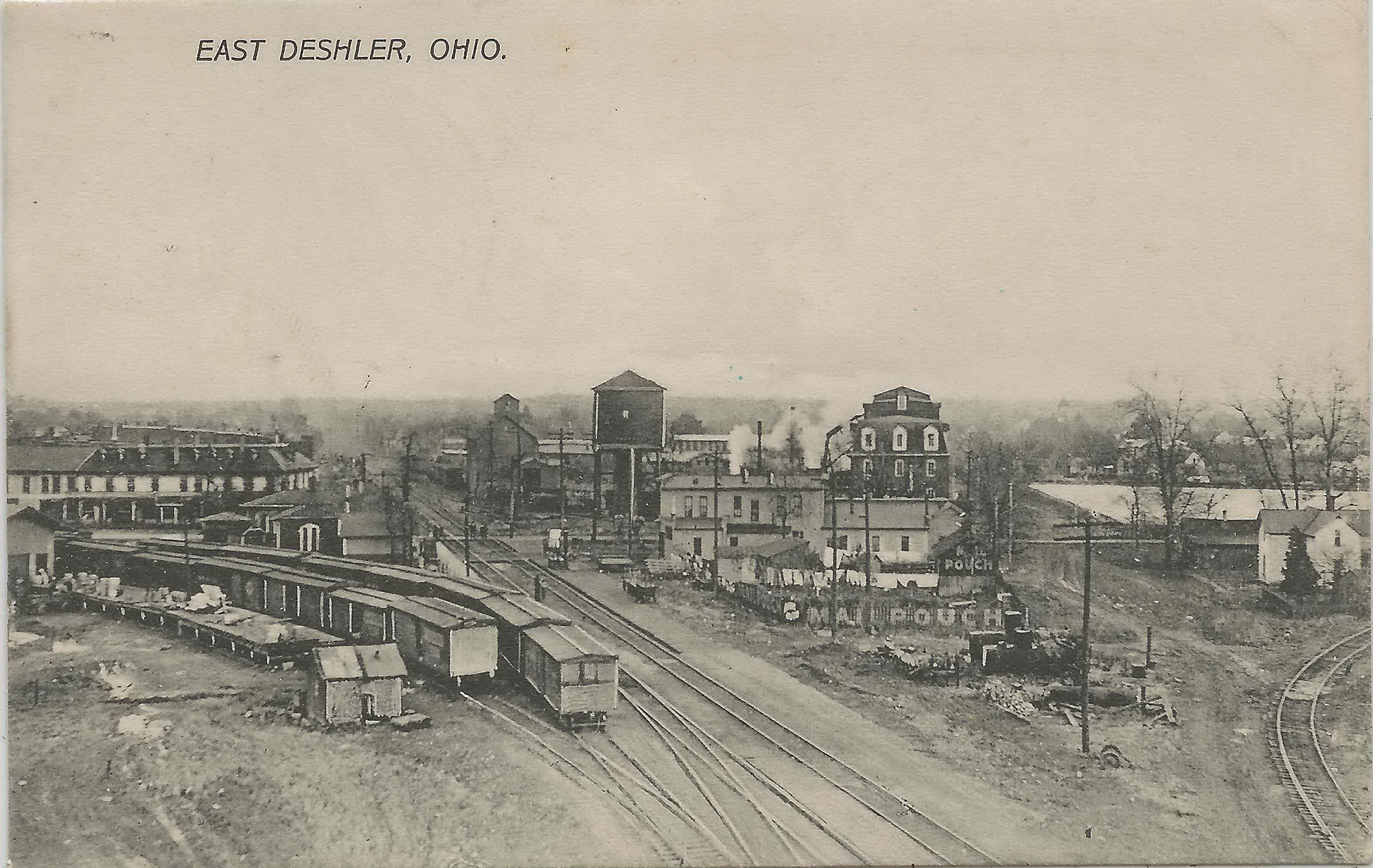

Marshall Stull

We have Division elections coming up. Please think about standing for an officer position.

Remember we are hosting the regional convention in 2020. We can never have too many volunteers. Let Dave McMullian know if you would like to help
